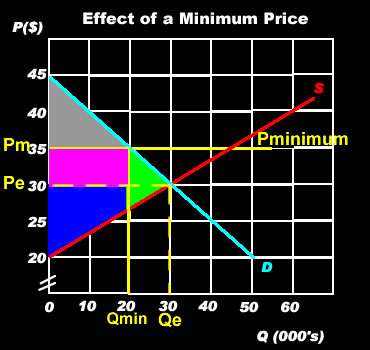IMPACT OF GOVERNMENT INTERVENTION
EFFECTS OF A QUOTA The diagram above shows that due to the introduction of a quota less of the good is now able to be consumed. This means that the equilibrium point is no longer able to be reached and resources are allocated inefficiently, resulting in deadweight loss (the area in green). Both consumer and producer surpluses are reduced with some of the consumer surplus being transferred to producers (the area in pink), meaning that society as a whole is worse off. DEFINITION: DEADWEIGHT LOSS - The loss in welfare to society cause by intervention in the market place. |
 |
EFFECT OF A MINIMUM PRICE The area in green shows the deadweight loss to society of the minimum price. The area in pink shows the consumer surplus which has been transferred to producers. By imposing a minimum price, producers receive a higher price for their product and may be better off – but at the cost of consumers being a lot worse off. The gains to producers is less than the total loss to consumers and society as a whole is worse off. |
 |
EFFECT OF A MAXIMUM PRICE With the imposition of a maximum price, the price is forced below the equilibrium price and there is a shortage in the market. Producer surplus is reduced and consumer surplus may increase but not by as much as the decrease in producer surplus. Some of the producer surplus is transferred to consumers (the area in pink) and society is worse off as a whole due to the inefficient use of resources - resulting in a deadweight loss (the area in green). |
 |